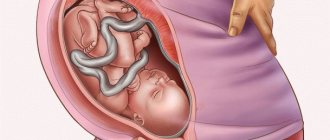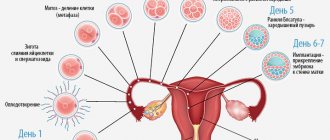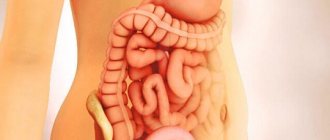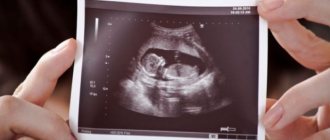The 37th week of pregnancy is a period of active preparation for future birth.
By the beginning of this week, the fetus is considered full-term: the organ systems have formed and are functioning fully. The baby is ready to be born, and the mother can look forward to meeting her baby with a light heart.
- What does the baby look like and what does he do?
- Development of the child's body
- Mom's feelings
- The first signs of imminent labor
- Possible problems
- Proper nutrition
- Why should you take vitamins and minerals?
- Physical activity of a woman
- Is intimacy possible?
- Being examined by a doctor
- If labor begins
What does the baby look like and what does he do?
At week 37, the child’s height reaches 48-50 cm, weight – 2.8-2.9 kg. The fetus occupies almost the entire space of the uterus, and now does not turn over in the womb - it only moves its arms and occasionally pushes.
The appearance of the baby is shaped - it looks like a newborn:
- facial features become clearer;
- individual fingerprints and marigolds appear on the fingers;
- lanugo (light fluff covering the body) disappears;
- nasal and ear cartilages harden;
- hair grows (from 0.5 to 4 cm);
- fat accumulates under the skin;
- the navel moves to the middle of the abdomen;
- the formation of the labia in girls and the scrotum in boys is completed;
- the skin brightens, turns pink, and becomes uniform in color.
During this period, the fetus sleeps a lot, and when it is awake, it behaves as in the first months after birth: sucking fingers, fists or the umbilical cord. Hearing and vision are well developed: the child recognizes and distinguishes parental voices, recognizes intonations of speech and responds with movements to loud sounds and pleasant music. He reacts to the environment and feels his mother’s mood - it is important to provide him with physiological comfort and a cozy psychological atmosphere.
How does a child’s body develop?
The bones of the skull, unlike cartilage, remain soft, and the fontanelles remain open. Nature ordered this to make it easier for the baby to overcome the narrow birth canal - in the process, the skull is slightly deformed. This is a type of norm and does not affect the health of the newborn in any way. It has been noted that children born by caesarean section have a perfectly even skull shape.
The fetus occupies the prenatal position: head to the pelvis. However, breech presentation (head up) can persist until delivery. While the body is preparing for them, there is a chance that the baby will still be able to turn over in the womb - such cases are not uncommon. If this does not happen before the end of the term, the obstetrician will have to resort to a scalpel so as not to harm the baby and mother.
At this time, the child should take a permanent position.
The functional systems of the child’s body begin to actively prepare for childbirth:
- the liver deposits blood and accumulates iron for hematopoiesis;
- Surfactant accumulates in the lungs, which promotes their opening in the newborn;
- the adrenal glands increase in size and begin to produce hormones necessary for proper breathing, activity and response to stress;
- neurons are covered with a myelin sheath, which is responsible for coordinating movements;
- in recent weeks, peristalsis has become more active;
- The mucous membranes of the gastrointestinal tract are covered with villous epithelium, necessary for the absorption of nutrients from food.
In the womb, the baby does not breathe in the traditional way; he only imitates this process by swallowing amniotic fluid and prepares for his first breath. At the moment of birth, the newborn’s lungs expand and the heart valve opens, through which blood flows through the vessels into the lungs for oxygenation.
How does mom feel?
The uterus reaches its maximum size during this week of pregnancy. Its volume is now about 5 liters, weight - 1 kg. Due to such an impressive volume and the presentation of the fetus with its head down, the pressure on the bladder of the expectant mother increases, which is fraught with a frequent urge to urinate.
Significant stress on the spine can cause back pain and shooting pain in the perineum. Expansion of the pelvis is accompanied by discomfort, tingling, aching pain in the lumbar and groin areas.
A woman's navel changes shape - it enlarges, becomes flat or protrudes outward. You shouldn't worry about this, because... After the baby is born, everything will gradually return to normal.
The time for the baby to be born is approaching, and the body begins to actively prepare for this. In late pregnancy, the ovaries produce relaxin, which is responsible for the expansion of the birth canal. This hormone promotes stretching of muscles and ligaments, softening of cartilage and normal opening of the cervix.
In recent weeks, the stomach becomes stiff and tight, but the tone is not a dangerous phenomenon at all. “Training” contractions can occur several times a day. To relieve tension, just relax, lie down in a comfortable position or take a warm bath.
A hot shower can help relieve a hard stomach.
If increased tone is accompanied by precursors of labor, you need to inform your doctor about it.
Ultrasound
Now you visit your gynecologist every week. He monitors the process of preparing your body for childbirth, examines the cervix and listens to the baby’s heartbeat. The third planned ultrasound examination is probably already behind us. However, in some cases, a repeat ultrasound may be necessary at 37 weeks of pregnancy. First of all, to clarify the location of the baby. We already know that the most physiological, optimal position for a baby “at the start” to meet his parents is cephalic presentation. However, the baby does not always settle down with his head down, and, having discovered on an ultrasound that the baby has not taken a suitable position, the doctor may consider the issue of delivery by cesarean section. When conducting an ultrasound examination, the specialist will also measure the size of the baby and their correspondence to the gestational age, assess the condition and amount of amniotic fluid, the degree of maturity of the placenta, the condition of the uterus and cervix, and the umbilical cord. If you are already completely ready for childbirth, engage in pediatric self-education. Research the topic of breastfeeding very carefully. There is nothing better for a newborn than mother’s milk: with a composition unique to your child, with mother’s antibodies, healthy, safe, always ready and free. In general, you need to fight for breast milk in any case if suddenly feeding becomes problematic. Prepare well for this. And also start learning the intricacies of caring for a newborn. In less than 5 minutes you are a real mother!
How to recognize the signs of imminent labor?
Gynecologists include the following signs as harbingers of impending childbirth:
- Breast swelling and colostrum release - the body is preparing for lactation.
- Descent of the abdomen due to the fact that the baby's head moves towards the cervix; Now it’s easier for mom to breathe, and the heartburn goes away, but the urge to go to the toilet becomes more frequent.
- The exit of the plug in the form of a lump of mucus, accompanied by nagging pain in the lower back and lower abdomen: in first-time mothers it occurs several days before childbirth, in second-time mothers it can happen immediately before it.
- Liquefaction of the stool indicates that the body is cleansing itself;
- Weight is reduced due to the fact that excess fluid leaves the body along with swelling;
- A surge of energy, or the so-called “nesting effect,” in which a pregnant woman, feeling a sudden surge of strength, takes on household chores and cleaning.
Harbingers warn of an approaching birth, but you should not be afraid. The body prepares gradually, and from the moment the symptoms first appear until the baby is born, it can take from 3 days to 2 weeks. Experienced mothers in labor know this and behave calmly, while firstborns begin to worry, and completely in vain.
In multiparous women, the warning signs appear more intensely than during the first birth.
You need to carefully monitor the discharge. Normally they should be milky in color. If you notice yellowish, brown or pink-yellow discharge in the form of stringy mucus, know that this is a plug coming off. During pregnancy, she covered the cervix, protecting the organ and fetus from microorganisms and bacteria; as the birth approaches, the need for it disappears.
Causes of pink discharge during pregnancy
“At the fourteenth week, I first began to experience mucus with small streaks of blood in it. Two days later everything went away. On the seventeenth, history repeated itself. I haven’t told the gynecologist about this yet. What could be the reason?"
The named shade of secretion most often indicates the presence of blood particles in the mucus. Their direct quantity affects the original color. There are quite a few reasons for the appearance of such discharge. But the most common is hormonal changes. Against this background, the sensitivity of the genital organs and mucous membranes significantly increases. In this regard, any contact actions inside the vagina can lead to microtrauma.
The appearance of pinkish mucus is often associated with examination on the chair. Additionally, some gynecological diseases are named among the causes. Thus, periodically bleeding (especially after sexual intercourse) erosion of the cervix often causes a peculiar shade of mucus.
During different periods of pregnancy, various processes occur in a woman’s body that affect the sexual secretion in a certain way. Only a doctor can correctly determine the cause based on the results of a vaginal examination, tests and ultrasound. If, in addition to this, additional symptoms are observed (spasms, burning, inflammation, etc.), then you should immediately contact an ambulance or your gynecologist.
“I noticed light pink discharge today at 35 weeks of pregnancy. There's nothing else to worry about. Is it dangerous?"
“The period is 21 weeks. Some kind of brownish smudge has appeared, and the stomach feels a little tight. What does this mean and how dangerous?”
Women often perceive pale pink discharge during pregnancy as a pathology. Of course, the doctor will not be able to immediately assure you otherwise, because This will require a full examination. According to statistics, most often this is indeed the result of completely natural phenomena (if the mucus is light and there are no other symptoms).
A larger amount of blood in the sexual secretion should alert the expectant mother. You need to seek help immediately if the amount has increased or the color has become darker. Intense scarlet discharge is a clear sign of a threatened miscarriage or a severe pathological process. If you seek help in time, you can save the child.
The situation is also dangerous when the mucus has turned brown or brown clots are observed in it. This means that there was some kind of injury or hematoma, and now the body is trying to get rid of the clotted blood. In such a situation, individual treatment is prescribed, possibly in a hospital. It includes a course of hormonal medications and vitamins that help maintain pregnancy. Appropriate therapy is selected based on a complete examination.
Light pink discharge during pregnancy can be caused by several factors. Some do not pose a danger to a woman, while others require professional treatment.
Causes of pinkish discharge:
- the presence of microscopic cracks in the mucous membrane of the genital organs;
- increased content of red blood cells in cervical mucus;
- hematoma in the birth canal, which the body gradually gets rid of spontaneously;
- minor injuries during sexual intercourse or after visiting a gynecologist;
- changes in hormonal levels due to conception;
- infectious diseases of the genital tract.
Pregnancy is often complicated by infectious diseases, in which pinkish or bloody secretions may appear. A pathogenic pathogen does not always enter a woman’s body after conception.
The infection could remain from a previous illness. Opportunistic bacteria exist in the human body for a long time without causing unpleasant symptoms. Only during pregnancy, when the defenses are reduced, does a woman develop an infectious inflammatory process.
Possible problems: how to detect violations in time?
You should pay attention to discharge that differs from the norm: an earthy tint indicates infection, blood indicates premature placental abruption. The infection threatens serious complications, and placental abruption, accompanied by sharp pain, is fraught with blood loss for the mother and oxygen starvation for the baby. Both conditions require immediate attention to a gynecologist.
Transparent or cloudy copious discharge indicates water leakage. Special amniotic pads, which are sold in pharmacies, will help to recognize this pathological condition in time. You can also carry out the test at home by placing a dry, clean diaper under yourself for 20 minutes. If after the test time a wet spot is discovered on the fabric, you should immediately contact your doctor.
Leakage is associated with rupture of the membranes - even if this rupture is minor, the likelihood of infection entering is very high. The obstetrician’s actions depend on the gestation period: at 37 weeks, the doctor will most likely order a caesarean section, and at an earlier period, he will prescribe drug antibiotic therapy.
Women with kidney and cardiovascular diseases are at high risk of developing preeclampsia, a dangerous form of late toxicosis (preeclampsia). It is accompanied by increases and surges in blood pressure, rapid accumulation of edema, disturbances in the functioning of the central nervous system: changes in hearing and vision, dizziness, etc. In this case, urine tests reveal a protein that should not normally be present. At the first frightening symptoms, you should consult a doctor, because... delay threatens with serious consequences for the mother and child (convulsions, oxygen deficiency, inhibition of the most important body functions).
You should also monitor the behavior and activity of the fetus. Normally, during this week he regularly moves in the womb: about 10 times in 12 hours. If the child is too restless, or, conversely, does not make itself felt for a long time, you need to see a gynecologist monitoring the pregnancy. Please note that before birth, movements normally become rare - the baby increases in size, and he no longer has enough free space in the womb.
If you do not observe movements for many hours, then you need to visit a doctor as soon as possible.
If a pathology is detected, a decision will be made on a caesarean section - such a measure will save the life of the child and the health of the mother. The current deadline allows this, because a mature fetus is physiologically ready for birth.
Discharge
The support of a loving spouse plays an important role.
At 37 weeks of pregnancy, take a close look at the discharge. If droplets of blood or thick mucous lumps are suddenly found on your underwear, then you must definitely tell your doctor about the finding; most likely, there is very little time left until day X, less than a week. Just remember that in general there should not be any heavy discharge during this period, except perhaps the discharge of the mucus plug, which was mentioned above.
This plug served as protection for the baby throughout the entire gestation period, because it did not allow infections and other aggressive processes and influences to enter the uterine body. Usually during sexual intercourse during this period, doctors recommend that spouses be extremely careful using condoms. After all, after the plug comes out, the baby is no longer so reliably protected from infections that can penetrate the uterus with sperm. Sometimes spotting, white or yellow, greenish or brown, may be detected at 37 weeks of pregnancy. There is an explanation for this.
White
A common occurrence at this time is a slight discharge of milky-white liquid with a possible, barely perceptible, smell of slightly sour milk, but not a strong one. A slight presence of mucus is also normal. If the discharge has acquired a cheesy structure, provokes an itchy sensation in the perineum and emits a distinct sour-milk odor, then this is similar to the development of candidiasis - an unpleasant but common disease in patients preparing for childbirth.
Foul white discharge of a foamy nature, emitting a stench similar to rotten fish, is considered dangerous. This is an undoubted sign of a sexually transmitted infection, which must be urgently treated before intrauterine infection of the baby or infection occurs during its passage through the mother’s genital tract. By the way, thrush also needs to be treated before birth.
Yellow
Sometimes, on the eve of the delivery process, a pregnant woman at 37 weeks of gestation may experience yellowish discharge. They are precisely the harbingers of childbirth.
- But yellow discharge should absolutely not have any unpleasant odor; it should not resemble a thick, foul-smelling liquid of unknown structure.
- If such pronounced unpleasant symptoms occur, then, most likely, infection has occurred as a result of unprotected sexual intercourse.
- To solve the problem, you urgently need to take a smear for microflora and sexually transmitted infections.
In this case, treatment requires antibiotic therapy, and quite powerful, potent drugs. Due to the patient's special situation, treatment will be delayed until the postpartum period. In the meantime, procedures will be needed to slow down the further development of the infection, and before birth, mandatory sanitation of the birth canal will be carried out in order to minimize the risk of contracting an infection to the child.
Reds
If pronounced red blood stains appear on your underwear, you should urgently call an ambulance. Such marks are considered the most dangerous sign at this stage, because they indicate premature placental abruption or its abnormal-pathological presentation, which is fraught with disastrous consequences. In such a situation, a threat to life hangs not only over the baby, but also over the mother herself. The main thing is not to hesitate if such symptoms occur; the sooner a woman gets to an obstetrician, the greater the chance of saving the baby’s life and saving the patient.
Brown
The diet of the expectant mother should be varied
If brownish discharge appears, there is no need to worry too much, especially if such liquid comes out periodically and mixed with mucous components. But you still need to discuss this issue with your obstetrician-gynecologist. At 37 weeks' gestation, such discharge is usually a characteristic symptom of impending delivery. Such discharge is characterized by a plug from the cervical canal, which has already been described above.
It cannot be ruled out that the baby may appear after such discharge within the next 24 hours, this is especially likely when painful contractions are associated with the plug. But it also happens that after the cork mucus is discharged, the patient continues to successfully complete her pregnancy for another two or even three weeks. The main thing is that this discharge does not have a bad odor, which can only indicate an infection.
Pink
It is quite acceptable if in the ninth month a pregnant woman develops sweetish-pink discharge. If they look like water, then most likely mommy has started leaking amniotic fluid. Moreover, it can be colorless, and not necessarily pink. And this shade is given to it by the slightly bleeding cervical canal, which is quite normal for patients preparing for motherhood for the first time.
Like brownish discharge, such marks are considered harbingers of rapidly approaching labor. But you must definitely monitor the volume of amniotic fluid; if too much of it is released, then this is no longer the norm - you must make an unscheduled visit to an obstetrician-gynecologist who can establish the true origin of such discharge and rule out dangerous conditions.
Greens
Such discharge should not normally be present in pregnant women at any time.
This is clear evidence that in the female body, in parallel with pregnancy, a serious inflammatory lesion of any reproductive organ develops. If the pathology affects the fallopian tubes or ovaries, then green discharge is a characteristic sign of such conditions.
This feature also requires medical intervention. After the necessary examination, the doctor will individually decide what further measures are necessary for the pregnant woman - to carry out treatment or wait for childbirth, containing the disease.
How to eat properly during this period?
During this period, expectant mothers may lose their appetite, which entails a weight loss of 1–2 kg. To maintain a healthy physical condition, doctors recommend giving preference to easily digestible foods rich in vitamins, microelements and healthy carbohydrates. Portions should be small, and the frequency of meals should be 5–7 times a day.
It is recommended to exclude salty, spicy and smoked foods from the diet, as they increase thirst, and drinking too much increases the load on the kidneys, resulting in edema.
The following products will be beneficial:
- milk;
- dairy products;
- cheese;
- vegetables;
- beef liver;
- cereals
During pregnancy, it is better to drink natural drinks with a mild diuretic effect: for example, lingonberry juice will help remove excess fluid from the body.
To avoid insomnia and heaviness in the stomach, it is recommended to refrain from eating 3 hours before bedtime. However, if you really want to have a snack, you should not deny yourself this, but preference should be given to light foods.
Recommendations for mothers
• During this period, try to rest more, unload your legs, taking a horizontal position and placing a cushion under them.
• Don't forget to wear a prenatal brace to help support your back and stomach.
• If you suddenly find mucus or a mucus plug in the discharge, you must immediately go to the maternity hospital.
• Avoid crowds of people to avoid contracting the flu or other unpleasant illnesses.
• If your bag for the maternity hospital is already completely packed, you can engage in pediatric self-education in your free time, paying more attention to the topic of breastfeeding and the nuances of caring for a newborn.
Why should you take vitamins and minerals?
Vitamin and mineral complexes recommended by the gynecologist must be taken in full.
- Calcium is especially important now. While in the womb, the child continues to grow, the bones increase in size, and his body needs a sufficient amount of this microelement. Calcium also helps the mother: by strengthening the walls of blood vessels, it prevents the formation of hemorrhoids and varicose veins.
- Another useful element is magnesium. It reduces the risk of developing seizures, relieves muscle spasms and has a beneficial effect on the nervous system: it reduces general excitability and calms the expectant mother.
- Iron is involved in the processes of hematopoiesis in the baby’s body, and vitamin C helps it to be fully absorbed, and together with calcium, supports blood vessels by increasing their elasticity.
Physical activity: recommendations and limitations
It is better to limit physical activity this week. Under the supervision of an instructor, it is allowed to perform light exercises to prepare the muscles for childbirth; You are allowed to cover only short distances at a slow pace on your own. Evening walks are useful in the fight against insomnia, which often bothers expectant mothers in the last weeks of pregnancy.
At this time, relaxation and peace are indicated - the woman should fully rest and conserve her strength before giving birth
Breathing exercises will bring much more benefits than physical education. Breathing training will help not only during pregnancy, but also during labor. It often happens that a woman in labor on the obstetric table has no idea how to breathe correctly in order to alleviate her condition and relieve acute pain.
Is intimacy possible?
Today, gynecologists unanimously claim that having sex in late pregnancy is not only possible, but also useful if no pathologies are observed during pregnancy. The reason for this is the presence in sperm of a substance that increases the elasticity of the cervix, which plays a big role in preparing for its opening.
In general, the possibility of intimacy this week should be assessed based on your own feelings. If sex does not bring discomfort, you can allow yourself pleasure, even if your lower abdomen is a little tight. Of course, poses in which your partner puts pressure on your stomach should be avoided.
When having sex, it is worth remembering that it is better to avoid positions in which the partner puts pressure on the already impressive size of the stomach.
When warning signs of impending labor and copious watery discharge appear, intimate life should be stopped.
Belly and uterus
The use of special products will help prevent the appearance of stretch marks
If the tummy has not yet dropped a week earlier, then it is quite possible that it will happen at 37 weeks, although it is possible that it was your stomach that decided to drop right before the birth itself. For every mother, this process occurs at its own time. But even after lowering, there is no need to wait in panic for the onset of labor; it may well take another week, or even two.
It’s better to enjoy the opportunity to breathe freely, because the belly has moved downwards and has stopped squeezing the respiratory structures. Although when breathing becomes easier, another problem appears - painful sensations arise in the lower abdomen, radiating to the lumbar area. It’s just that now the fetus’s head has dropped into the pelvic area, its pressure has increased, which is why a pulling, aching and painful sensation occurs. If they are constantly present in the lower back and abdomen, then this is a clear harbinger of the upcoming delivery.
The navel now looks downwards, pressure is constantly felt on the bladder, which prompts mommy to run to the toilet almost every 10 minutes. At the same time, the uterus is already in some tone, it is tense.
What does the doctor check during the examination?
In the last weeks before childbirth, doctors pay attention to the following indicators:
- cervical condition,
- fetal presentation,
- the width of the pelvis of the expectant mother.
At 37 weeks of pregnancy, the cervix becomes soft and thin, and in some cases even begins to dilate. Its changes occur gradually and are usually accompanied by aching sensations in the lower abdomen. To determine the degree of dilatation, the doctor examines the pregnant woman on a gynecological chair.
During the examination, he also takes a smear to exclude disturbances in the vaginal microflora. If tests show the presence of a fungal or bacterial infection, timely treatment will prevent it from ascending the birth canal towards the fetus.
After this, the doctor measures the circumference of the pregnant woman’s abdomen, her weight and assesses the physiological state based on the presence of edema, blood pressure, urine tests and, if necessary, biochemical blood data.
An ultrasound at 37 weeks is performed only for medical reasons: for example, in case of suspected umbilical cord entanglement in the baby’s neck and oxygen deficiency.
Fetal development at 37 weeks of gestation
- The fetal liver continues to actively accumulate iron, which is so necessary for its subsequent hematopoiesis.
- The baby's body produces the hormones required for its life.
- Now the hormone cortisone is produced, which promotes the maturation of the child’s lungs.
- Your baby's adrenal glands become larger, producing an important hormone necessary to reduce stress when the baby is born.
- A special protective shell, necessary for coordination of movements, envelops the baby’s neurons.
- At the 37th week of pregnancy, your baby will already be able to suckle at the breast, is able to digest food, and the original feces - meconium - has formed in his intestines.
- Heat exchange processes are also more active, the skin of the fetus has thickened, and fat has accumulated under it.
- The ear and nasal cartilages become harder, and the bones of the skull remain pliable and flexible, which will greatly help the baby overcome obstacles during the birth process.
Your baby is already in a certain position, which will remain until birth. In most cases, the baby turns head down, but there are other types of presentation. The baby's fontanelles will remain completely open.
How can you tell when labor is starting?
If false contractions, during which the lower abdomen pulls and turns to stone, are replaced by true contractions - with a gradual reduction in intervals and increased pain - it’s time to go to the maternity hospital. In most cases, they are preceded by the discharge of amniotic fluid. By this week, it is worth preparing in advance a bag with things that mother and baby will need in the ward.
Statistics show that multiparous women sometimes experience rapid labor. If you are one of them, then you cannot hesitate, because... contractions may intensify faster than during the first birth.
So, at this stage you should not be afraid of complications if the pregnancy proceeds calmly and the fetus develops normally. The expectant mother needs to take care of herself, worry less, observe the child’s behavior and control her condition.
Pain
Aching nagging pain in the lower abdomen and lower back is a sure sign of imminent delivery. During this period, you will also experience pain in your back, sacrum, and spine.
A large belly and additional weight cause pain in the legs. Most likely, you will also continue to experience pain in the pelvic bones, pubis and sacrum. They weaken and disperse under the action of the hormone relaxin. And plus, the fetus also puts pressure on the fundus of the uterus.











